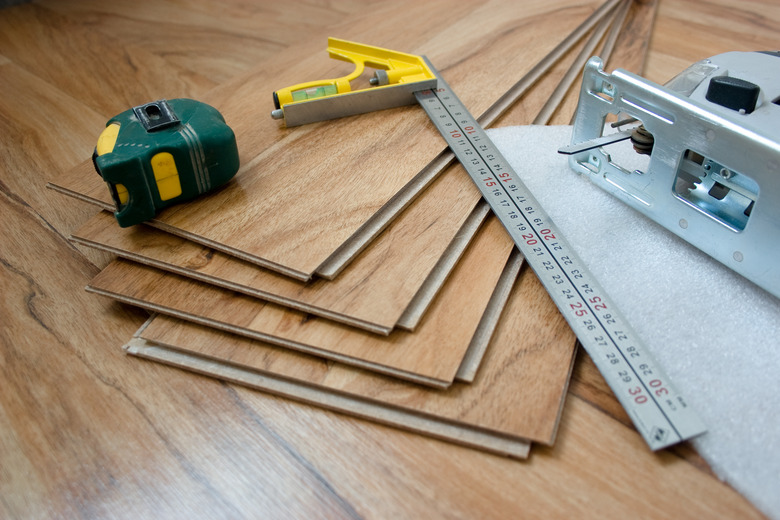Preparing Floor For Laminate
The subfloor doesn't need as much preparation for laminate flooring as it does for other types of flooring, primarily because laminate flooring "floats," which means it isn't physically anchored to the subflooring. The subfloor needs to be clean and flat, of course, and an underlayment is usually required unless you're installing laminate flooring with an integrated underlayment layer.
One important thing to remember is that the subfloor must meet the manufacturer's moisture requirements, and if you doubt that it does, you should not install laminate flooring until the subfloor dries out, or the warranty will be void.
Preparing a Wood or Concrete Subfloor
Preparing a Wood or Concrete Subfloor
You can install laminate flooring directly over some types of existing flooring, including hardwood, vinyl and tiles that are in good condition, but if you're removing carpeting or some other existing floor covering prior to installing laminate flooring, it's important to remove all staples, nails and adhesive from the wood or concrete subfloor.
This can be tedious at times because the only way to remove staples is to pull out each one with a screwdriver or pliers, and the only way to remove old adhesive is to scrape it off, although some flooring pros use a drum sander to make the job of removing adhesive from a wood subfloor easier.
To make a wood or concrete subfloor ready for laminate flooring, you also have to:
- Pry off the baseboards. If you're going to reuse them, number them and stack them outside the installation space.
- Sand or grind down high spots, which are any spots that rise more than 1/8 inch above the surrounding surface. Swiss Krono recommends dragging a laminate board on its edge across the floor to find these spots.
- Fill low spots that sink 1/8 inch or more below the surrounding surface with leveling compound. You can also find these with the on-edge laminate plank.
- Pound down any nails and set any screws that stick up.
- Stop squeaks by driving additional screws to secure the subflooring to the floor joists.
- Sweep and vacuum the floor.
Check for Moisture
Check for Moisture
Moisture is most often a problem with a concrete subfloor. An easy way to check for moisture is to tape a piece of sheet plastic to the floor and leave it overnight. Peel up the plastic in the morning; if there is condensation on the underside of the plastic, then the concrete needs to dry out.
A more accurate way to check for moisture is to use a moisture meter. It has a noninvasive probe that you can move from place to place and a meter that measures in percentages. Typical acceptable moisture levels are 4 percent for concrete and 12 percent for wood, but check the manufacturer's recommendations for the product you're using because moisture requirements vary.
Undercut the Door Jambs
Undercut the Door Jambs
One of the most egregious amateur mistakes you can make when installing laminate flooring is to wrap it around the door jambs, creating a small gap that you have to fill with caulk. Pros always cut the bottoms off the jambs and the door trim so you can slide the flooring underneath.
The best tool for this job is a Japanese-style pull saw (or a similar tool called an undercut saw), but you can also use a back saw, a dovetail saw or even a regular handsaw in a pinch. Place a spare piece of the new laminate (and underlayment, as applicable) on the floor in front of the jamb and lay the saw flat on top of it with the teeth facing the jamb to give you the correct cutting height, and then saw away. It's best to do this during the prep stage so you don't have to stop and do it in the middle of the floor installation.
Install Laminate Flooring Underlayment
Install Laminate Flooring Underlayment
Laminate flooring underlayment comes in many materials, and the type you choose will depend on how much moisture protection, thermal insulation, cushioning and soundproofing you need. The three types recommended by Floor Critics are foam, cork and felt.
- Foam is the least expensive, and it provides a moisture barrier but not much thermal or sound insulation.
- Cork is a middle-of-the-road choice. It's not too expensive and has better thermal and sound-absorbing properties than foam, but it isn't the best choice for high-moisture situations, such as installation over a crawl space.
- Felt is the best overall underlayment, and it also costs more than cork or foam. It provides superior thermal and sound insulation and provides an excellent cushion.
Keep in mind that most types of underlayment do not constitute a true moisture barrier. When installing laminate over a concrete subfloor, for example, it is usually recommended that you install plastic sheeting directly over the concrete before adding the underlayment.
Underlayment comes in 3-foot rolls that you unroll over the subfloor and tape together along the seams. To be sure it covers the entire floor, let it ride up the walls by about 2 inches and cut off the excess later. Tape seams with the tape recommended by the manufacturer and do not overlap the edges of the underlayment.
Acclimate the Flooring
Acclimate the Flooring
Before you install any type of flooring, whether it's laminate or hardwood or even vinyl tiles, you should always spread the flooring around the installation space and give it time to acclimate to the moisture and temperature conditions. Most manufacturers recommend an acclimation period of three to five days.


